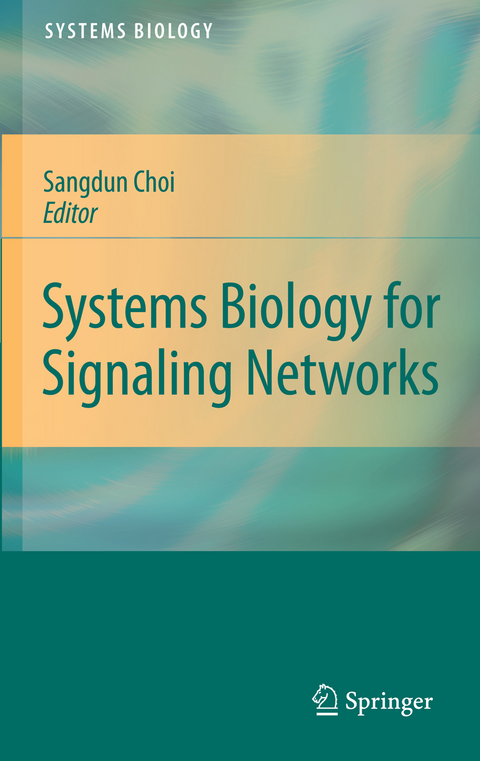Systems Biology for Signaling Networks
Springer-Verlag New York Inc.
978-1-4419-5796-2 (ISBN)
System Biology encompasses the knowledge from diverse fields such as Molecular Biology, Immunology, Genetics, Computational Biology, Mathematical Biology, etc. not only to address key questions that are not answerable by individual fields alone, but also to help in our understanding of the complexities of biological systems. Whole genome expression studies have provided us the means of studying the expression of thousands of genes under a particular condition and this technique had been widely used to find out the role of key macromolecules that are involved in biological signaling pathways. However, making sense of the underlying complexity is only possible if we interconnect various signaling pathways into human and computer readable network maps. These maps can then be used to classify and study individual components involved in a particular phenomenon. Apart from transcriptomics, several individual gene studies have resulted in adding to our knowledge of key components that are involved in a signaling pathway. It therefore becomes imperative to take into account of these studies also, while constructing our network maps to highlight the interconnectedness of the entire signaling pathways and the role of that particular individual protein in the pathway. This collection of articles will contain a collection of pioneering work done by scientists working in regulatory signaling networks and the use of large scale gene expression and omics data. The distinctive features of this book would be: Act a single source of information to understand the various components of different signaling network (roadmap of biochemical pathways, the nature of a molecule of interest in a particular pathway, etc.), Serve as a platform to highlight the key findings in this highly volatile and evolving field, and Provide answers to various techniques both related to microarray and cell signaling to the readers.
Concepts.- Systems Biology Approaches: Solving New Puzzles in a Symphonic Manner.- Current Progress in Static and Dynamic Modeling of Biological Networks.- Getting Started in Biological Pathway Construction.- From Microarray to Biology.- Modeling and Reconstruction.- Computational Procedures for Model Identification.- Assembly of Logic-Based Diagrams of Biological Pathways.- Automating Mathematical Modeling of Biochemical Reaction Networks.- Strategies to Investigate Signal Transduction Pathways with Mathematical Modelling.- Inferring Transcriptional Regulatory Network.- Finding Functional Modules.- Modeling the Dynamics of Biological Networks from Time Course Data.- Decision Making in Cells.- Robustness of Neural Network Models.- Functional Modules in Protein–Protein Interaction Networks.- Mixture Model on Graphs: A Probabilistic Model for Network-Based Analysis of Proteomic Data.- Integration of Network Information for Protein Function Prediction.- Applications for Signaling Networks.- Cellular-Level Gene Regulatory Networks: Their Derivation and Properties.- Tyrosine-Phosphoproteome Dynamics.- Systems Biology of the MAPK1,2 Network.- Pathway Crosstalk Network.- Crosstalk Between Mitogen-Activated Protein Kinase and Phosphoinositide-3 Kinase Signaling Pathways in Development and Disease.- Systems-Level Analyses of the Mammalian Innate Immune Response.- Molecular Basis of Protective Anti-Inflammatory Signalling by Cyclic AMP in the Vascular Endothelium.- Construction of Cancer-Perturbed Protein–Protein Interaction Network of Apoptosis for Drug Target Discovery.- Transcriptional Changes in Alzheimer’s Disease.- Pathogenesis of Obesity-Related Chronic Liver Diseases as the Study Case for the Systems Biology.- The Evolving Transcriptome of Head and Neck SquamousCell Carcinoma.- Peptide Microarrays for a Network Analysis of Changes in Molecular Interactions in Cellular Signalling.- Tools for Systems Biology.- A Primer on Modular Mass-Action Modelling with CellML.- FERN – Stochastic Simulation and Evaluation of Reaction Networks.- Programming Biology in BlenX.- Discrete Modelling: Petri Net and Logical Approaches.- ProteoLens: A Database-Driven Visual Data Mining Tool for Network Biology.- MADNet: A Web Server for Contextual Analysis and Visualization of High-Throughput Experiments.- Erratum to: Functional Modules in Protein–Protein Interaction Networks.
| Reihe/Serie | Systems Biology |
|---|---|
| Zusatzinfo | XVI, 908 p. |
| Verlagsort | New York, NY |
| Sprache | englisch |
| Maße | 155 x 235 mm |
| Themenwelt | Mathematik / Informatik ► Informatik ► Theorie / Studium |
| Medizin / Pharmazie ► Medizinische Fachgebiete | |
| Studium ► 2. Studienabschnitt (Klinik) ► Humangenetik | |
| Studium ► Querschnittsbereiche ► Infektiologie / Immunologie | |
| Naturwissenschaften ► Biologie ► Genetik / Molekularbiologie | |
| Naturwissenschaften ► Biologie ► Mikrobiologie / Immunologie | |
| Naturwissenschaften ► Biologie ► Zellbiologie | |
| ISBN-10 | 1-4419-5796-0 / 1441957960 |
| ISBN-13 | 978-1-4419-5796-2 / 9781441957962 |
| Zustand | Neuware |
| Informationen gemäß Produktsicherheitsverordnung (GPSR) | |
| Haben Sie eine Frage zum Produkt? |
aus dem Bereich




